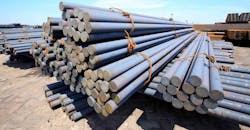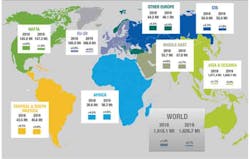Global steel demand will continue to rise in 2018 and 2019, having resumed stability and consistency in 2017 after two years of volatility and contraction. In its latest Short-Range Outlook, the World Steel Assn pegged the 2018 steel demand at 1.62 billion metric tons, 1.8% higher than 2017, and forecast 2019 demand to rise 0.7% again to 1.63 billion metric tons.
“In the next couple of years, the global economic situation is expected to remain favorable with high confidence and strengthening recovery of investment levels in advanced economies,” explained T.V. Narendran, chairman of the World Steel Economics Committee. “Benefitting from this, steel demand in both developed and developing economies is expected to show sustained growth momentum with risks relatively limited.”
World Steel represents steelmakers in 64 countries. For 2017, it reported global steel production totaled 1.69 billion metric tons, the second consecutive year of rising output. For the current year, global steel production totals 276.65 million metric tons, 4.0% higher than the comparable total for 2017.
In its Short-Range Outlook of global demand, World Steel found that global steel demand is benefitting from economic momentum across all regions, and yet still faces risks from global trade tensions. In the current situation, a “virtuous cycle for steel demand” has been created by high levels of economic confidence and continued strong investment activity, as well as recovering commodity prices.
In 2019, a slower rate of forecast demand growth is anticipated based on ongoing deceleration of the Chinese economy, and weakening investment momentum due to rising interest rates.
The forecast also cautions about the negative economic effects to be expected if trade tensions continue to rise. It also foresees inflationary pressure and tighter monetary policies in the U.S. and European Union, which would encourage financial market volatility and trouble for emerging economies.
China, the largest steel-producing and –consuming economy, presents a particular challenge. In 2017, government stimulus measures boosted construction activity, but investment continued to decelerate and steel demand increased only moderately in China.
For 2018 and 2019, World Steel forecasts China GDP will grow at a slower rate than in 2017, which will be matched by slower rates of construction spending. Steel demand in 2018 is expected to remain level for 2018, and then decline by 2.0% in 2019 as construction activity continues to decline.
In the developed markets, mainly the U.S. and EU, steel demand is forecast to rise 1.8% in 2018, and then slow by 1.1% in 2019.
The outlook for steel demand in the U.S. remains very strong, World Steel noted, citing solid economic fundamentals (strong consumption and investment levels, rising incomes, and low interest rates.) Manufacturing demand is supported by a weak dollar and rising levels of business investment, with rising housing prices and steady commercial real-estate development. World Steel even suggested some risk of the U.S. economy “overheating” thanks to excess demand.
The anticipated U.S. infrastructure stimulus plan is unlikely to affect steel demand in the short term, according to the World Steel study.
Automotive market activity in the U.S. and EU is expected to moderate due to a “saturation effect” and rising interest rates, while industrial machinery production is seen benefitting from rising investment.
Steel demand in emerging and developing economies (excluding China) is expected to increase by 4.9% in 2018, and 4.5% in 2019, according to the forecast.
About the Author
Robert Brooks
Content Director
Robert Brooks has been a business-to-business reporter, writer, editor, and columnist for more than 20 years, specializing in the primary metal and basic manufacturing industries.


